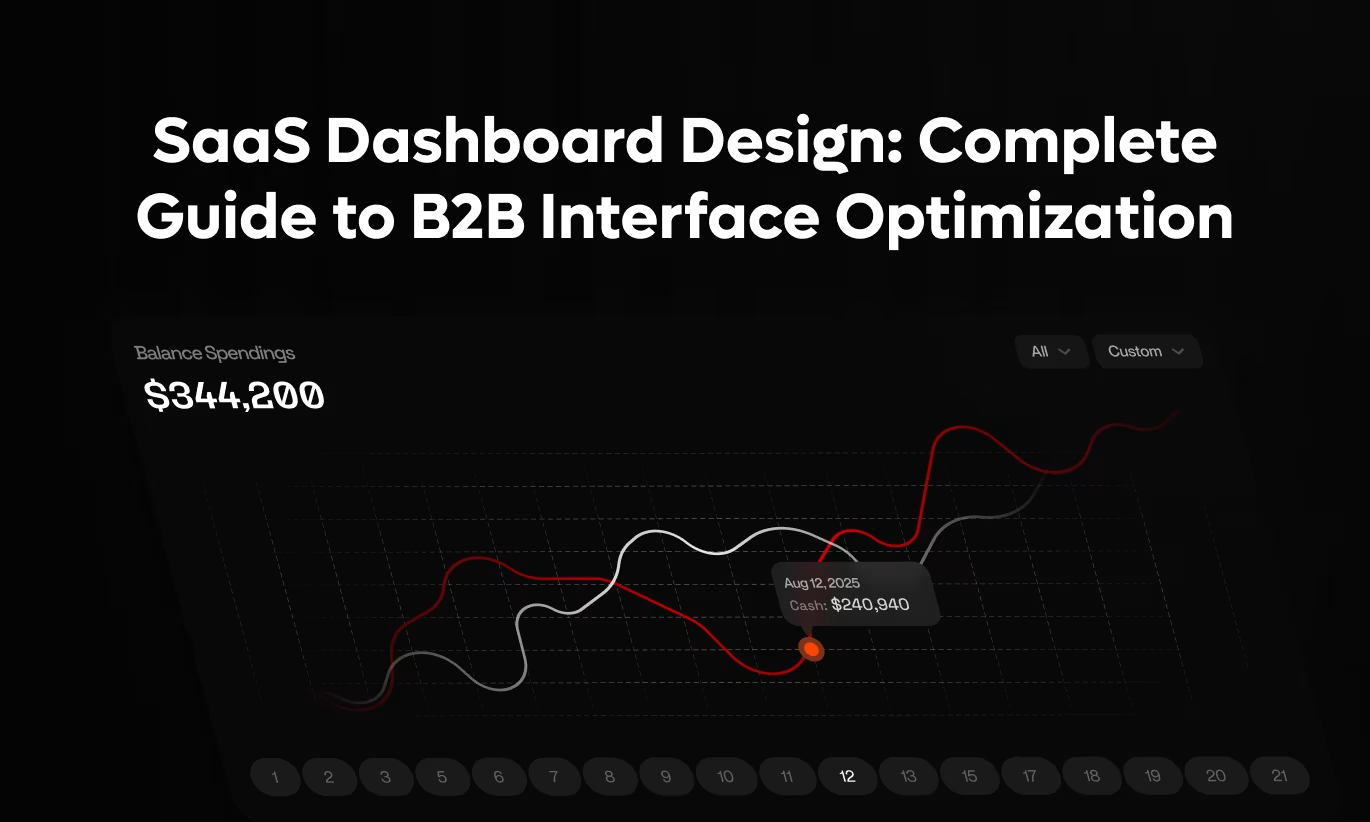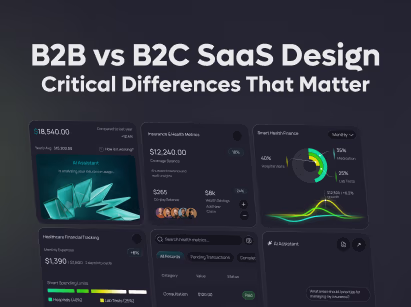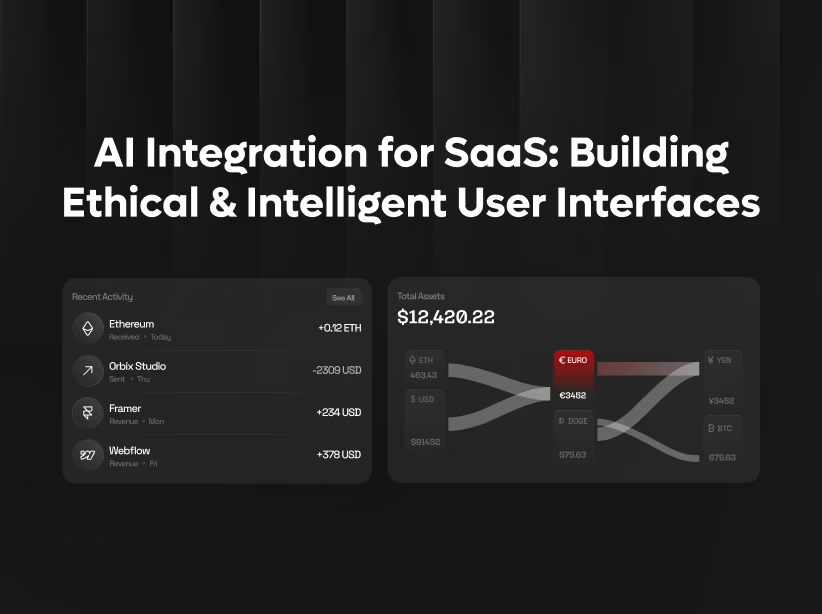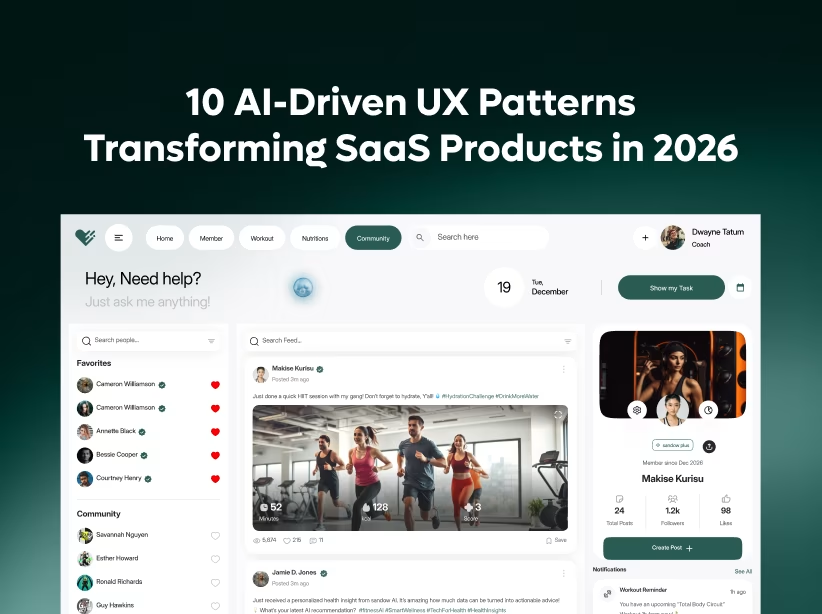
SaaS dashboards are where users spend 80% of their time, make critical business decisions, and form lasting impressions about your product's value. Yet most B2B interfaces suffer from information overload, poor hierarchy, and confusing navigation—causing user frustration, support tickets, and ultimately churn. Research shows that well-designed SaaS dashboards increase user engagement by 40%, reduce support costs by 30%, and improve retention by 25% compared to poorly optimized interfaces.
The difference between dashboards users love and those they tolerate lies in strategic B2B interface optimization: clear information hierarchy, actionable data visualization, intuitive navigation, and performance that respects user time. This complete guide reveals essential SaaS dashboard design principles that transform overwhelming data displays into powerful, user-friendly interfaces driving engagement and business value.
Understanding B2B SaaS Dashboard Design Fundamentals
Before diving into specific tactics, understanding what makes B2B dashboard design unique provides crucial context.
B2B versus consumer design differences:
B2B users prioritize efficiency over delight—they're completing work tasks, not seeking entertainment. Dashboards must enable rapid information scanning, quick decision-making, and seamless workflow completion. Unlike consumer apps where simplicity reigns supreme, B2B interfaces balance power user needs for complexity with accessibility for occasional users.
The dashboard paradox: Users want comprehensive data access but become overwhelmed when everything appears simultaneously. Successful SaaS dashboard design solves this through progressive disclosure, customization, and intelligent defaults showing most-relevant information prominently while keeping additional data accessible.
Essential SaaS Dashboard Design Principles
1. Establish Clear Visual Hierarchy
Information hierarchy determines whether users find critical data in seconds or struggle through visual chaos.
Hierarchy implementation strategies:
Size and prominence with primary KPIs displayed largest and most prominently, secondary metrics in medium sizing, and supporting details smallest.
Color strategically using brand colors sparingly for emphasis, neutral backgrounds preventing distraction, and semantic colors (green for positive, red for negative) only when meaningful.
Positioning matters placing critical information top-left (natural starting point for Western readers), secondary data center and right, with tertiary information below fold.
Visual weight through bold text for important numbers, regular weight for labels, and light weight for descriptions creating clear emphasis.
Whitespace generously separating distinct information groups, providing breathing room around important data, and preventing cramped overwhelming layouts.
Example: Salesforce dashboards prioritize revenue metrics prominently with supporting details accessible through drill-down, maintaining clarity despite complex data.
2. Design for Scanning, Not Reading
B2B users scan dashboards quickly looking for specific information or anomalies. Dashboard UX design must support rapid information extraction.
Scannable design tactics:
Grid-based layouts organizing information predictably so users know where to look for specific data types.
Consistent card design with standardized header placement, metric positioning, and action button locations enabling pattern recognition.
Descriptive labels using clear, specific titles rather than vague headings. "Monthly Recurring Revenue" beats "Revenue" for B2B SaaS interfaces.
Visual grouping clustering related metrics logically by function, workflow, or decision context.
Progressive disclosure hiding complexity behind expandable sections, drill-down interactions, or separate detail views.
Data density balance showing enough information for context without overwhelming—typically 5-7 primary metrics per screen.
3. Optimize Data Visualization for Decision-Making
Charts and graphs should communicate insights instantly, not require interpretation effort.
Effective data visualization principles:
Choose appropriate chart types: Line charts for trends over time, bar charts for category comparisons, pie charts (sparingly) for part-to-whole relationships, and tables only for precise number lookup.
Minimize chart junk removing unnecessary gridlines, decorative effects, 3D distortions, and excessive labels that clutter without adding value.
Use color purposefully limiting palette to 3-4 colors maximum, using color to highlight insights not just decoration, and maintaining sufficient contrast for accessibility.
Provide context showing comparison periods (last month, last year), targets or benchmarks, and trend indicators (up/down arrows, percentage changes).
Interactive exploration enabling hover tooltips for details, click-through to underlying data, and filtering without leaving dashboard context.
Real-time updates where valuable, with clear indicators showing data freshness and automatic refresh options.
Impact: Well-designed data visualization reduces time-to-insight by 50-70% compared to raw data tables.
4. Create Flexible, Customizable Interfaces
B2B users have diverse roles, priorities, and workflows. One-size-fits-all dashboards frustrate everyone.
Customization strategies:
Role-based defaults providing pre-configured views for common personas (executives, managers, analysts) while allowing personalization.
Drag-and-drop widgets letting users rearrange dashboard components matching their priorities and workflows.
Saved views enabling users to create and switch between multiple dashboard configurations for different contexts.
Custom metrics allowing users to define calculated fields, custom reports, or personalized KPIs beyond system defaults.
Filter persistence remembering user preferences for date ranges, segments, and filters across sessions.
Export options providing CSV, PDF, or scheduled email reports for users needing data outside the dashboard.
Example: Tableau's dashboard builder exemplifies customization done right—users can create entirely custom views while defaults provide immediate value.
5. Design Intuitive Navigation Architecture
Users abandon dashboards they can't navigate. Clear information architecture is fundamental to B2B interface optimization.
Navigation best practices:
Persistent primary navigation keeping core sections always accessible via top or side navigation preventing disorientation.
Breadcrumbs showing current location and hierarchy enabling easy backtracking in complex applications.
Search functionality allowing users to jump directly to specific reports, metrics, or features rather than browsing menus.
Contextual actions placing relevant buttons and tools near related data rather than hiding in distant menus.
Clear labeling using business terminology users understand rather than internal technical jargon.
Shallow hierarchy enabling access to any feature within 2-3 clicks from homepage preventing endless clicking.
Mobile considerations ensuring responsive navigation works on tablets and phones where users increasingly access B2B SaaS.
6. Prioritize Performance and Speed
Slow dashboards kill productivity and user satisfaction. Performance is UX.
Performance optimization:
Fast initial load displaying skeleton screens or cached data instantly while fresh data loads in background.
Lazy loading deferring below-fold content and secondary visualizations until needed.
Efficient queries optimizing database queries and API calls, implementing pagination for large datasets, and caching frequently accessed data.
Progressive enhancement showing basic information immediately, adding complexity incrementally as data loads.
Background updates refreshing data without forcing full page reloads or disrupting user context.
Target metrics: Initial meaningful paint under 1.5 seconds, full dashboard load under 3 seconds, and smooth 60fps interactions.
Impact: Reducing load time from 5 seconds to 2 seconds typically increases engagement 25-40%.
7. Implement Actionable Design
Dashboards aren't just for viewing—they're for doing. The best SaaS dashboard design enables direct action from insights.
Action-oriented features:
Inline editing allowing data updates directly in views without navigating to separate edit screens.
Contextual buttons placing relevant actions near insights: "Contact customer" next to churn risk indicators.
Quick filters enabling instant data slicing through dropdown filters, date pickers, or segment selectors.
Drill-down paths providing clear routes from high-level metrics to detailed underlying data.
Bulk actions supporting multi-select operations for efficiency when managing multiple items.
Workflow integration connecting dashboard actions to other tools (send email, create task, update CRM) without context switching.
8. Design for Different User Types
B2B SaaS dashboards serve executives, managers, and individual contributors with vastly different needs.
Multi-level dashboard strategy:
Executive dashboards showing high-level KPIs, trends, and alerts with minimal detail—answering "How is the business performing?"
Manager dashboards balancing overview metrics with team performance, resource allocation, and operational metrics.
User dashboards providing detailed data, task-focused views, and tools for daily work completion.
Customizable depth allowing each user type to drill deeper when needed while maintaining appropriate default views.
Common SaaS Dashboard Design Mistakes
Information overload attempting to show everything simultaneously creating overwhelming visual noise that hinders rather than helps decision-making.
Vanity metrics prominently displaying impressive but non-actionable numbers (total users ever) while burying meaningful metrics (monthly active users, churn rate).
Poor color usage using too many colors, insufficient contrast, or relying on color alone to convey information excluding colorblind users.
Static data showing outdated snapshots without clear timestamps, refresh options, or real-time updates when valuable.
Ignoring mobile designing only for desktop when 30-40% of B2B users access dashboards on tablets or phones.
Complex navigation requiring excessive clicks to find information or hiding important features in nested menus.
No empty states showing blank screens when users have no data yet instead of guiding them toward first actions.
Industry-Specific Dashboard Considerations
Marketing dashboards: Campaign performance, conversion funnels, lead sources, ROI metrics, with real-time data crucial.
Sales dashboards: Pipeline visibility, deal tracking, quota attainment, activity metrics, with mobile access critical.
Finance dashboards: Cash flow, revenue recognition, expense tracking, forecasting, with precise numerical accuracy paramount.
Operations dashboards: Efficiency metrics, resource utilization, SLA tracking, incident management, with alert prominence essential.
Analytics dashboards: User behavior, feature adoption, retention cohorts, growth metrics, with flexible segmentation important.
Measuring Dashboard Success
Track these metrics validating design effectiveness:
Engagement metrics:
- Daily active dashboard users
- Time spent in dashboard
- Feature adoption rates
- Workflow completion rates
Efficiency metrics:
- Time to find specific information
- Clicks required for common tasks
- Search usage frequency
- Support ticket volume
Satisfaction metrics:
- User satisfaction scores (CSAT)
- Net Promoter Score (NPS)
- Feature request themes
- Dashboard abandonment rates
Business metrics:
- User retention correlation
- Feature upsell conversion
- Customer success efficiency
- Product-qualified lead generation
Implementation Roadmap
Week 1-2: Research and Audit
- Analyze current usage patterns and pain points
- Interview diverse user types about needs
- Benchmark against best-in-class competitors
- Document technical constraints
Week 3-6: Design and Prototype
- Create information architecture
- Design visual hierarchy and layouts
- Develop interactive prototypes
- Conduct usability testing
Week 7-10: Development and Testing
- Implement responsive layouts
- Optimize performance
- Test across devices and users
- Refine based on feedback
Week 11-12: Rollout and Iteration
- Phased deployment with monitoring
- Gather user feedback systematically
- Address critical issues rapidly
- Plan ongoing optimization
Conclusion: Dashboard Design as Competitive Advantage
Exceptional SaaS dashboard design isn't about aesthetic beauty—it's about enabling users to extract insights, make decisions, and take action efficiently. B2B interface optimization that prioritizes clear hierarchy, scannable layouts, actionable design, and customization transforms dashboards from necessary evils into competitive advantages driving engagement, satisfaction, and retention.
Every minute users spend struggling with poor dashboard design costs productivity and erodes product perception. Conversely, well-optimized dashboards become indispensable tools users champion internally and externally.
The investment in strategic dashboard design delivers compounding returns: reduced support costs, improved user efficiency, higher retention rates, and stronger product-market fit. In competitive SaaS markets, superior interface design often determines winners.
At Orbix Studio, we specialize in B2B SaaS dashboard design that balances power with usability. Our proven methodology combines user research, data visualization expertise, and iterative testing to create interfaces users love and businesses depend on.
Ready to transform your SaaS dashboard into a competitive advantage?
Free SaaS Dashboard Audit
Get a complimentary optimization analysis:
✓ Information hierarchy evaluation
✓ Data visualization effectiveness review
✓ Navigation and workflow assessment
✓ Performance benchmarking
✓ Prioritized improvement recommendations
✓ Estimated impact on engagement metrics
Limited to 5 SaaS companies monthly | Value: $4,500
Fresh UI/UX Ideas, Straight to Your Inbox





